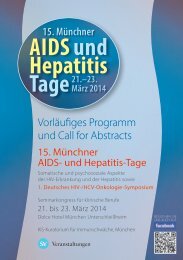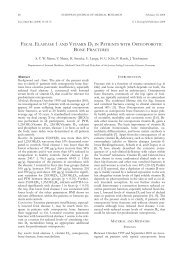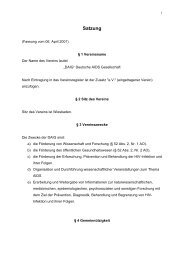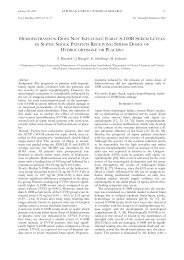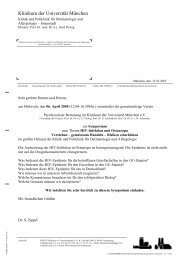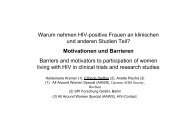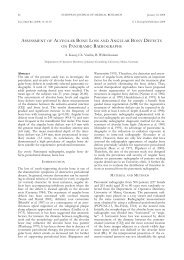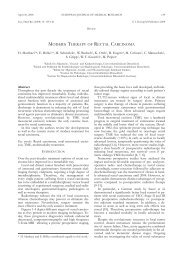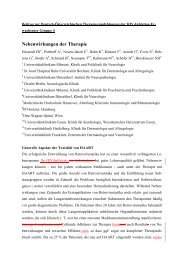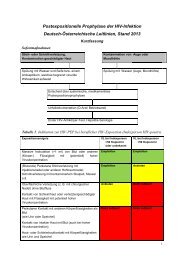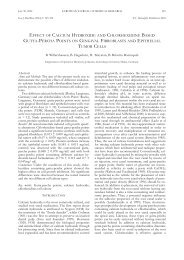efficacy and tolerability of a spray with salvia officinalis in the ...
efficacy and tolerability of a spray with salvia officinalis in the ...
efficacy and tolerability of a spray with salvia officinalis in the ...
You also want an ePaper? Increase the reach of your titles
YUMPU automatically turns print PDFs into web optimized ePapers that Google loves.
20<br />
Abstract<br />
Objective: This r<strong>and</strong>omised, double-bl<strong>in</strong>d, parallel<br />
group phase II/III study <strong>with</strong> adaptive two-stage design<br />
<strong>and</strong> <strong>in</strong>terim analysis compared <strong>the</strong> <strong>efficacy</strong> <strong>and</strong><br />
<strong>tolerability</strong> <strong>of</strong> <strong>spray</strong> (conta<strong>in</strong><strong>in</strong>g a Salvia <strong>of</strong>fic<strong>in</strong>alis fluid<br />
extract) aga<strong>in</strong>st placebo <strong>in</strong> <strong>the</strong> treatment <strong>of</strong> patients<br />
<strong>with</strong> acute viral pharyngitis.<br />
Study Participants: <strong>in</strong> two study parts, a total <strong>of</strong> 286<br />
patients <strong>with</strong> subjective <strong>and</strong> objective evidence <strong>of</strong><br />
pharyngitis were r<strong>and</strong>omized. In <strong>the</strong> 1 st study part 122<br />
patients were enrolled. In <strong>the</strong> 2 nd study part 164 patients<br />
were <strong>in</strong>cluded. The treatment duration per patient<br />
was 3 days, <strong>in</strong>clud<strong>in</strong>g one basel<strong>in</strong>e visit <strong>and</strong> one<br />
f<strong>in</strong>al visit.<br />
Ma<strong>in</strong> Outcome Measures: Area under Curve for change<br />
<strong>of</strong> throat pa<strong>in</strong> <strong>in</strong>tensity (spontaneous pa<strong>in</strong>), documented<br />
every 15 m<strong>in</strong>utes <strong>with</strong><strong>in</strong> <strong>the</strong> first 2 hours after <strong>the</strong><br />
first application as compared to basel<strong>in</strong>e us<strong>in</strong>g a visual<br />
analog scale (VAS 100 mm).<br />
Results: Follow<strong>in</strong>g <strong>the</strong> <strong>in</strong>terim analyses <strong>of</strong> <strong>the</strong> first<br />
study part <strong>the</strong> 15 % <strong>spray</strong>* conta<strong>in</strong><strong>in</strong>g 140 µl sage extract<br />
per dose was <strong>the</strong> most promis<strong>in</strong>g preparation for<br />
<strong>the</strong> 2 nd study part (ma<strong>in</strong> study) whereas for <strong>the</strong> 30%<br />
<strong>and</strong> <strong>the</strong> 5% preparation results made superiority over<br />
placebo unlikely <strong>in</strong> <strong>the</strong> f<strong>in</strong>al analysis. Overall, <strong>the</strong> 15 %<br />
<strong>spray</strong> was significantly superior to placebo for <strong>the</strong> primary<br />
<strong>efficacy</strong> variable <strong>with</strong> regard to a reduction <strong>of</strong><br />
<strong>the</strong> throat pa<strong>in</strong> <strong>in</strong>tensity score. Only m<strong>in</strong>or side effects<br />
such as dry pharynx or burn<strong>in</strong>g <strong>of</strong> mild <strong>in</strong>tensity were<br />
seen.<br />
Conclusions: The <strong>efficacy</strong> <strong>and</strong> <strong>tolerability</strong> pr<strong>of</strong>ile <strong>of</strong> a<br />
15 % sage <strong>spray</strong> <strong>in</strong>dicated that this preparation provides<br />
a convenient <strong>and</strong> safe treatment for patients <strong>with</strong><br />
acute pharyngitis. A symptomatic relief occurred <strong>with</strong><strong>in</strong><br />
<strong>the</strong> first two hours after first adm<strong>in</strong>istration <strong>and</strong> was<br />
statistically significantly superior to placebo.<br />
EUROPEAN JOURNAL OF MEDICAL RESEARCH January 31, 2006<br />
Eur J Med Res (2006) 11: 20-26 © I. Holzapfel Publishers 2006<br />
EFFICACY AND TOLERABILITY OF A SPRAY WITH SALVIA OFFICINALIS IN<br />
THE TREATMENT OF ACUTE PHARYNGITIS –<br />
A RANDOMISED, DOUBLE-BLIND, PLACEBO-CONTROLLED STUDY WITH<br />
ADAPTIVE DESIGN AND INTERIM ANALYSIS<br />
M. Hubbert 1, H. Sievers 2, R. Lehnfeld 2, W. Kehrl 3<br />
1 Sidroga GmbH, Bad Säck<strong>in</strong>gen, Germany<br />
2 PhytoLab GmbH & Co. KG, Vestenbergsgreuth, Germany<br />
3 Kl<strong>in</strong>ik und Ambulatorium für HNO-Krankheiten, Marienkrankenhaus, Hamburg, Germany<br />
* Valverde ® Salvia Rachen<strong>spray</strong>. Sidroga AG, Untere Brühlstraße,<br />
CH-4800 Z<strong>of</strong><strong>in</strong>gen<br />
Key words: acute pharyngitis, sage extract, pharyngeal<br />
<strong>spray</strong>, cl<strong>in</strong>ical trial<br />
INTRODUCTION<br />
Acute pharyngitis is one <strong>of</strong> <strong>the</strong> most common illnesses<br />
for which patients go to see <strong>the</strong>ir doctor. The ma<strong>in</strong><br />
cl<strong>in</strong>ical symptoms are sore throat, fever <strong>and</strong> malaise.<br />
In addition, odynophagia, dysphagia, <strong>and</strong> purulent exudates<br />
can be present (Marvez-Valls 1998, Bisno<br />
2001). The most common causes are viral <strong>in</strong>fections<br />
(see Table 1). Normally, <strong>the</strong> illness is mild <strong>and</strong> selflimit<strong>in</strong>g<br />
but may worsen due to bacterial super<strong>in</strong>fection,<br />
most commonly by group A or group C β-hemolytic<br />
streptococci. Serious sequelae such as<br />
rheumatic fever or endocarditis may follow bacterial<br />
super<strong>in</strong>fection (Bisno 2001). Table 1 gives an overview<br />
<strong>of</strong> <strong>the</strong> different microbial causes <strong>of</strong> acute<br />
pharyngitis.<br />
Because <strong>of</strong> <strong>the</strong>se sequelae, bacterial causes <strong>of</strong> <strong>the</strong><br />
pharyngitis must be ruled out or, if positive, be treated<br />
<strong>with</strong> antibiotics. However, due to <strong>the</strong> predom<strong>in</strong>antly<br />
viral cause antibiotics have only a m<strong>in</strong>or benefit upon<br />
<strong>the</strong> resolution <strong>of</strong> pharyngitis symptoms. Thus, <strong>in</strong> most<br />
cases <strong>the</strong> treatment <strong>of</strong> acute pharyngitis is symptomatic<br />
focuss<strong>in</strong>g on <strong>the</strong> management <strong>of</strong> fever <strong>and</strong> pa<strong>in</strong>.<br />
Normally, because <strong>of</strong> its benign nature, symptomatic<br />
treatment can start immediately. Among a variety <strong>of</strong><br />
substances which belong to <strong>the</strong> NSAID group (nonsteroidal<br />
anti-<strong>in</strong>flammatory drugs), as a non chemically<br />
def<strong>in</strong>ed drug Salvia <strong>of</strong>fic<strong>in</strong>alis preparations may be<br />
beneficial due to <strong>the</strong>ir recommended use (Commission<br />
1985 <strong>and</strong> 1990, ESCOP 1996 <strong>and</strong> 2003) which is<br />
supported by <strong>the</strong> documented anti-<strong>in</strong>flammatory,<br />
anti-nociceptive <strong>and</strong> astr<strong>in</strong>gent properties <strong>of</strong> sage<br />
compounds. Beneficial cl<strong>in</strong>ical experiences <strong>with</strong> sage<br />
preparations for <strong>the</strong> prophylaxis <strong>of</strong> oral mucositis also<br />
support <strong>the</strong>ir use <strong>in</strong> <strong>the</strong>se conditions (Leitl<strong>in</strong>ien Supportive<br />
Therapie 2002).<br />
Therefore, to support <strong>the</strong> <strong>in</strong>dication acute pharyngitis<br />
a cl<strong>in</strong>ical trial was performed details <strong>of</strong> which will<br />
be presented <strong>in</strong> this paper.
January 31, 2006 EUROPEAN JOURNAL OF MEDICAL RESEARCH<br />
21<br />
Table 1. Microbial causes <strong>of</strong> acute pharyngitis (modified acc. to BISNO 2001).<br />
viral pathogens bacterial pathogens Chlamydiae Mykoplasmae<br />
Rh<strong>in</strong>ovirus Streptococcus pyogenes Chlamydia pneumoniae Mycoplasma<br />
Coronavirus (group A β-hemolytic streptococci) pneumoniae<br />
Adenovirus Group C β-hemolytic<br />
Herpes simplex virus streptococci<br />
Para<strong>in</strong>fluenza virus Neisseria gonorrhoeae<br />
Influenzavirus Corynebacterium diphteriae<br />
Coxsackievirus Aranobacterium<br />
Epste<strong>in</strong>-Barr virus haemolyticum<br />
Cytomegalovirus<br />
Human<br />
immunodeficiency<br />
virus type 1<br />
PRODUCT PROFILE<br />
Salvia <strong>of</strong>fic<strong>in</strong>alis L., also known as Dalmatian sage, belongs<br />
to <strong>the</strong> Lamiaceae family. The genus Salvia comprises<br />
500 - 900 species (Hager 2004). Many <strong>of</strong> <strong>the</strong>m,<br />
e.g. Salvia <strong>of</strong>fic<strong>in</strong>alis, S. triloba, S. div<strong>in</strong>orum, S. lav<strong>and</strong>ulifolia,<br />
S. miltiorrhiza, are used <strong>the</strong>rapeutically. In<br />
addition, different sage preparations are also used as<br />
spices or food antioxidants.<br />
The parts <strong>of</strong> <strong>the</strong> plant ma<strong>in</strong>ly used for <strong>the</strong>rapeutic<br />
purposes are <strong>the</strong> leaves, which have a monograph each<br />
from <strong>the</strong> Commission E <strong>and</strong> ESCOP (Commission E<br />
1985 <strong>and</strong> 1990, ESCOP 2003). Today, <strong>the</strong> medic<strong>in</strong>al<br />
use <strong>of</strong> Salvia <strong>of</strong>fic<strong>in</strong>alis preparations <strong>in</strong> Germany is<br />
based on <strong>the</strong> Commission E monograph (Commission<br />
E 1985 <strong>and</strong> 1990) <strong>and</strong> on <strong>the</strong> German St<strong>and</strong>ard License<br />
(St<strong>and</strong>ardzulassungen 1996) for sage leaf <strong>in</strong>fusion.<br />
Salvia preparations are used <strong>in</strong>ternally for dyspeptical<br />
compla<strong>in</strong>ts <strong>and</strong> hyperhidrosis <strong>of</strong> different etiology.<br />
The external application comprises <strong>the</strong> treatment <strong>of</strong><br />
<strong>in</strong>flammation <strong>of</strong> <strong>the</strong> oral <strong>and</strong> pharyngeal mucosa, g<strong>in</strong>givitis<br />
or pressure po<strong>in</strong>ts <strong>of</strong> <strong>the</strong> denture. Fur<strong>the</strong>rmore,<br />
traditional use <strong>in</strong>cludes gastropathy, loss <strong>of</strong> apetite,<br />
meteorism, diarrhea <strong>and</strong> enteritis. Sage preparations<br />
were already applied <strong>in</strong> ancient times (Lippmann <strong>and</strong><br />
Wegener 2001): thus, <strong>the</strong> traditional experience comprises<br />
several thousend years <strong>of</strong> <strong>in</strong>ternal <strong>and</strong> external<br />
application.<br />
Different sage preparations exhibited bactericidal,<br />
fungicidal <strong>and</strong> antiviral activities <strong>in</strong> vitro. Rosmar<strong>in</strong>ic<br />
acid, an important constituent <strong>of</strong> sage, was shown to<br />
have anti-<strong>in</strong>flammtory properties (ESCOP 1996).<br />
These anti-<strong>in</strong>flammatory activities could be confirmed<br />
<strong>in</strong> <strong>in</strong> vivo experiments (ESCOP 2003). Pharmacok<strong>in</strong>etic<br />
data follow<strong>in</strong>g oral application <strong>of</strong> sage extracts<br />
are not available. Follow<strong>in</strong>g <strong>the</strong> monographs, sage<br />
preparations do not show undesirable effects (ESCOP<br />
2003).<br />
Salvia <strong>of</strong>fic<strong>in</strong>alis conta<strong>in</strong>s 1 - 2,5 % <strong>of</strong> essential oil<br />
which consists ma<strong>in</strong>ly <strong>of</strong> thujone (ca. 35 - 60 %), fur<strong>the</strong>rmore<br />
c<strong>in</strong>eol, camphor, borneol, bornylacetat, camphen,<br />
l<strong>in</strong>alool, α- und β-p<strong>in</strong>en, viridiflorol, α- und β−<br />
caryophyllen. Non-volatile substances are tann<strong>in</strong>s (3 -<br />
7 %), e. g. rosmar<strong>in</strong>ic acid, <strong>and</strong> <strong>the</strong> bitter diterpenes<br />
carnosol und salv<strong>in</strong>. The flavonoid content <strong>of</strong> sage<br />
leaf is ca. 1 - 3 %. Fur<strong>the</strong>rmore triterpenes, predom<strong>in</strong>antly<br />
ursolic acid <strong>and</strong> oleanolic acid, have been described<br />
(Commission E 1985 und 1990, Pachaly 1990,<br />
Hager 2004). Thujone, <strong>the</strong> major component <strong>of</strong> sage<br />
oil, is known to be toxic (Hager 2004). However, thujone<br />
concentrations <strong>in</strong> licensed medic<strong>in</strong>al products<br />
based on <strong>the</strong> provisions <strong>of</strong> <strong>the</strong> <strong>of</strong>ficial monographs are<br />
uncritical. No side effects <strong>of</strong> such products related to<br />
thujone have been reported.<br />
Valverde ® Salvia Rachen<strong>spray</strong> is a new medic<strong>in</strong>al<br />
product presented as a pump <strong>spray</strong> <strong>in</strong> a glass flacon.<br />
The <strong>the</strong>rapeutically active pr<strong>in</strong>ciple is a sage leaf fluid<br />
extract (1:1, extraction solvent ethanol 70 % [V/V].<br />
The product conta<strong>in</strong>s 15 % <strong>of</strong> <strong>the</strong> extract <strong>in</strong> an aqueous<br />
solution. The droplet size is 50 – 60 µm, thus big<br />
enough not to pass <strong>in</strong>to <strong>the</strong> lower respiratory tract.<br />
One glass flacon holds 12 ml <strong>of</strong> <strong>the</strong> solution. Placebo<br />
was identically composed regard<strong>in</strong>g ethanol <strong>and</strong> excipient<br />
concentration. It conta<strong>in</strong>ed a pharmacologically<br />
<strong>in</strong>active amount <strong>of</strong> 0.3% sage leaf extract for appropriate<br />
bl<strong>in</strong>d<strong>in</strong>g.<br />
Per s<strong>in</strong>gle application, three puffs (= 3 times a metered<br />
dose <strong>of</strong> 140 µl) will be taken, <strong>the</strong> maximum use<br />
is three applications per day. The product is claimed<br />
for <strong>the</strong> short term treatment <strong>of</strong> acute pharyngitis.<br />
To our knowledge, <strong>the</strong>re are no similar approved<br />
products available on <strong>the</strong> European market. Thus,<br />
<strong>spray</strong> will be <strong>the</strong> first market entry <strong>with</strong><strong>in</strong> Europe.<br />
METHODS<br />
STUDY PARTICIPANTS<br />
This r<strong>and</strong>omised, double-bl<strong>in</strong>d, placebo-controlled,<br />
multicentre, parallel-group study <strong>with</strong> adaptive design<br />
<strong>and</strong> <strong>in</strong>terim analysis compared three different concentrations<br />
<strong>of</strong> <strong>spray</strong> <strong>with</strong> placebo <strong>in</strong> <strong>the</strong> 1 st study part. Between<br />
December 2001 <strong>and</strong> February 2002 altoge<strong>the</strong>r<br />
122 patients were recruited from 16 centers (n = 31 on<br />
<strong>the</strong> 30 % <strong>spray</strong>, n = 31 on <strong>the</strong> 15 % <strong>spray</strong>, n = 30 on
22 EUROPEAN JOURNAL OF MEDICAL RESEARCH<br />
January 31, 2006<br />
<strong>the</strong> 5 % <strong>spray</strong>, n = 30 on placebo). Dur<strong>in</strong>g <strong>the</strong> <strong>in</strong>terim<br />
analysis a sample-size re-assessment was done, based<br />
on <strong>the</strong> treatment effect observed <strong>in</strong> <strong>the</strong> first study<br />
part. Fur<strong>the</strong>r 80 patients per group were to be recruited.<br />
Actually, <strong>in</strong> <strong>the</strong> 2 nd study part (ma<strong>in</strong> study) 164 patients<br />
from 21 centers were <strong>in</strong>cluded from April 2002<br />
until June 2002 (n = 82 on <strong>the</strong> 15 % <strong>spray</strong> <strong>and</strong> n = 82<br />
on placebo). Male <strong>and</strong> female patients aged 18 years<br />
<strong>and</strong> older <strong>with</strong> symptoms <strong>of</strong> acute pharyngitis exist<strong>in</strong>g<br />
for max. 48 hours were eligible for participation <strong>in</strong> this<br />
study. The patients required typical signs (spontaneous<br />
pa<strong>in</strong>, local <strong>in</strong>flammation) <strong>of</strong> pharyngitis confirmed by<br />
<strong>the</strong> study physician. Additionally, all participants had<br />
to document <strong>the</strong>ir spontaneous pa<strong>in</strong> <strong>in</strong>tensitiy on a visual<br />
analog scale (VAS) (to be eligible a m<strong>in</strong>imum value<br />
<strong>of</strong> 40 mm was necessary on a VAS 100 mm). They<br />
were excluded from study participation <strong>in</strong> case <strong>of</strong> a<br />
positive test on group A β-hemolytic streptococci,<br />
concomitant illnesses as rh<strong>in</strong>os<strong>in</strong>usitis, laryngitis, tracheitis,<br />
bronchitis, fever, wounds or o<strong>the</strong>r significant<br />
changes <strong>in</strong> <strong>the</strong> oral cave, unallowed comedication, o<strong>the</strong>r<br />
pa<strong>in</strong> situations like dental or tumor pa<strong>in</strong>, requir<strong>in</strong>g<br />
<strong>the</strong> <strong>in</strong>take <strong>of</strong> analgetic medication, operations <strong>in</strong> <strong>the</strong><br />
oropharynx area up to 4 weeks prior to <strong>the</strong> study,<br />
seizures, or any known hypersensitivity aga<strong>in</strong>st <strong>the</strong><br />
study medication. Fur<strong>the</strong>rmore, pregnant or lactat<strong>in</strong>g<br />
women <strong>and</strong> women <strong>of</strong> childbear<strong>in</strong>g potential who<br />
were not tak<strong>in</strong>g adequate contraceptive precautions<br />
were excluded. The 1 st study part was conducted at 16<br />
doctor’s <strong>of</strong>fices, <strong>in</strong> <strong>the</strong> 2 nd study part 21 doctor’s <strong>of</strong>fices<br />
were <strong>in</strong>volved.<br />
Written <strong>in</strong>formed consent was obta<strong>in</strong>ed from each<br />
patient. The study protocol was approved by <strong>the</strong> Human<br />
Ethics Commitee at <strong>the</strong> University <strong>of</strong> Munich<br />
<strong>and</strong> was conducted <strong>in</strong> accordance <strong>with</strong> <strong>the</strong> Declaration<br />
<strong>of</strong> Hels<strong>in</strong>ki <strong>and</strong> <strong>the</strong> European guidel<strong>in</strong>es for Good<br />
Cl<strong>in</strong>ical Practice.<br />
STUDY DESIGN<br />
Two visits per patient were to be done. At <strong>the</strong> first visit,<br />
follow<strong>in</strong>g <strong>in</strong>formed consent <strong>and</strong> check <strong>of</strong> <strong>the</strong> <strong>in</strong>clusion<br />
<strong>and</strong> exclusion citeria, <strong>the</strong> diagnosis acute pharyngitis<br />
was confirmed by <strong>the</strong> treat<strong>in</strong>g physician. Dur<strong>in</strong>g<br />
<strong>the</strong> first 2 hours <strong>the</strong> patient had to stay <strong>in</strong> <strong>the</strong> doctor’s<br />
<strong>of</strong>fice. Prior to <strong>the</strong> first application <strong>of</strong> 3 puffs spontaneous<br />
throat pa<strong>in</strong> was estimated by <strong>the</strong> patient on a<br />
100 mm VAS for basel<strong>in</strong>e value (at least 40 mm necessary<br />
for <strong>in</strong>clusion <strong>in</strong> <strong>the</strong> study). Dur<strong>in</strong>g <strong>the</strong> first 2<br />
hours pa<strong>in</strong> <strong>in</strong>tensitiy was assessed every 15 m<strong>in</strong>utes<br />
<strong>and</strong> documented accord<strong>in</strong>gly <strong>in</strong> a pa<strong>in</strong> diary <strong>in</strong> <strong>the</strong><br />
doctor’s <strong>of</strong>fice. Thereafter, all subsequent pa<strong>in</strong> measurements<br />
were done <strong>and</strong> documented accord<strong>in</strong>gly at<br />
home <strong>in</strong> <strong>the</strong> pa<strong>in</strong> diary <strong>the</strong> use <strong>of</strong> which was expla<strong>in</strong>ed<br />
previously by <strong>the</strong> study personal. The follow<strong>in</strong>g treatment<br />
phase consisted <strong>of</strong> two more applications on<br />
treatment day one, three applications on day two <strong>and</strong><br />
one last application <strong>in</strong> <strong>the</strong> morn<strong>in</strong>g before <strong>the</strong> f<strong>in</strong>al<br />
visit. All applications were made up <strong>of</strong> 3 puffs each.<br />
EFFICACY AND TOLERABILITY MEASUREMENTS<br />
The primary <strong>efficacy</strong> variable <strong>in</strong> both study parts was<br />
<strong>the</strong> change <strong>of</strong> throat pa<strong>in</strong> <strong>in</strong>tensity (spontaneous<br />
pa<strong>in</strong>), documented every 15 m<strong>in</strong>utes <strong>with</strong><strong>in</strong> <strong>the</strong> first 2<br />
hours after <strong>the</strong> first application as compared to basel<strong>in</strong>e<br />
us<strong>in</strong>g <strong>the</strong> 100 mm VAS; <strong>the</strong> area under <strong>the</strong> curve<br />
(AUC) <strong>of</strong> <strong>the</strong> pa<strong>in</strong> <strong>in</strong>tensity differences (PID) was assessed.<br />
The secondary endpo<strong>in</strong>ts <strong>in</strong> both study parts were:<br />
• mean<strong>in</strong>gful pa<strong>in</strong> relief (MPR): max. 50 % <strong>of</strong> <strong>the</strong><br />
basel<strong>in</strong>e value on VAS<br />
• complete pa<strong>in</strong> reduction after first application<br />
• change <strong>of</strong> throat pa<strong>in</strong> <strong>in</strong>tensity dur<strong>in</strong>g study treatment<br />
(accord<strong>in</strong>g to patient’s diary)<br />
• number <strong>of</strong> patients <strong>with</strong> early treatment discont<strong>in</strong>uation<br />
due to lack <strong>of</strong>f <strong>efficacy</strong><br />
• overall <strong>efficacy</strong> assessment both by <strong>the</strong> physician<br />
<strong>and</strong> by <strong>the</strong> patient<br />
• overall safety assessment both by <strong>the</strong> physician <strong>and</strong><br />
by <strong>the</strong> patient<br />
• adverse events (AE)<br />
The statistical evaluation <strong>of</strong> secondary endpo<strong>in</strong>ts<br />
was done after <strong>the</strong> completion <strong>of</strong> <strong>the</strong> 2 nd study part.<br />
STATISTICAL ANALYSIS<br />
Superiority vs. placebo for <strong>the</strong> three <strong>salvia</strong> preparations<br />
was tested <strong>in</strong> an adaptive two-stage design accord<strong>in</strong>g<br />
to Bauer/Köhne. In <strong>the</strong> <strong>in</strong>terim analysis each<br />
<strong>salvia</strong> preparation was compared to placebo via<br />
Wilcoxon-Mann-Whitney-U-Tests. Of <strong>the</strong> doses show<strong>in</strong>g<br />
promis<strong>in</strong>g results only one dose was to be selected<br />
for <strong>the</strong> second study stage <strong>and</strong> to be compared versus<br />
placebo <strong>the</strong>reafter.<br />
To control <strong>the</strong> overall type I error rate (2.5% onesided)<br />
a bonferroni adjustment was used. The stopp<strong>in</strong>g<br />
boundaries <strong>in</strong> <strong>the</strong> <strong>in</strong>terim analyses were α 1 =<br />
0.00365 (success) <strong>and</strong> α 0 = 0.3 (futility). The critical<br />
value for <strong>the</strong> comb<strong>in</strong>ation test was c α = 0.001062.<br />
Descriptive anaylsis: Mean <strong>and</strong> 95 % Confidence Intervalls<br />
(CIs) were determ<strong>in</strong>ed <strong>in</strong> <strong>the</strong> AUC (PID) by<br />
treatment groups <strong>and</strong> <strong>the</strong> differences <strong>in</strong> <strong>the</strong> AUC<br />
(PID) between treatment groups.<br />
Collectives: per-protocol collective (PP) was chosen for<br />
primary analysis; <strong>the</strong> full analysis collective (FAS) for<br />
used for secondary analysis; all miss<strong>in</strong>g values were determ<strong>in</strong>ed<br />
by <strong>the</strong> Last Observation Carried Forward-<br />
(LOCF)-method.<br />
RESULTS<br />
PATIENT DEMOGRAPHICS<br />
A total <strong>of</strong> 286 patients were r<strong>and</strong>omised to treatment<br />
<strong>with</strong> <strong>spray</strong> or placebo. The distribution can be seen <strong>in</strong><br />
Table 2.<br />
Treatment groups were generally well matched for<br />
demographic <strong>and</strong> basel<strong>in</strong>e cl<strong>in</strong>ical features. Although<br />
<strong>the</strong> patient collective <strong>in</strong> <strong>the</strong> 15 % group appeared to be<br />
slightly younger than <strong>in</strong> <strong>the</strong> o<strong>the</strong>r groups <strong>the</strong>re was no<br />
statistically significant difference among <strong>the</strong> treatment<br />
groups.
January 31, 2006 EUROPEAN JOURNAL OF MEDICAL RESEARCH<br />
23<br />
Table 2.<br />
Part 1 Verum SII (30 %) Verum S2 (15 %) Verum S3 (5 %) Placebo<br />
patients total n = 31 n = 31 n = 30 n = 30<br />
Male 10 15 11 10<br />
Female 21 16 19 20<br />
mean age 42.7 36.0 40.9 40.1<br />
(range 20 - 77) yrs. (range 18-70) yrs. (range 20-77) yrs. (range 19-78) yrs.<br />
Part 2 Verum S2 (15 %) Placebo<br />
patients total n = 82 n = 82<br />
Male 24 31<br />
Fernale 58 51<br />
mean age 44.1 41.2<br />
(range 18-00) yrs. (range 19-86) yrs.<br />
EFFICACY<br />
Primary <strong>efficacy</strong> variables<br />
Figs. 1 (part 1) <strong>and</strong> 2 (part 2) show <strong>the</strong> mean PID values<br />
(PP collective 1 st study part) over 2 hours after <strong>the</strong><br />
first application (VAS reduction <strong>in</strong> mm).<br />
Fig. 1. Follow<strong>in</strong>g paired comparison <strong>of</strong> <strong>the</strong> AUCs <strong>of</strong><br />
PID versus placebo, <strong>the</strong> p-vaiues were as follows (for<br />
study part 1): Verum Sl (30 % m/m) vs. placebo: p =<br />
0.475; Verum S2 (15 % m/m) vs. placebo: p = 0.093;<br />
Verum S3 (5 % m/m) vs. placebo: p = 0.420.<br />
Fig. 2. The p-value follow<strong>in</strong>g comparison <strong>of</strong> <strong>the</strong> AUCs<br />
<strong>of</strong> PID versus placebo is as follows (study part 2):<br />
Verum S2 (15 m/m) vs. placebo 0.0021. The mean<br />
basel<strong>in</strong>e VAS value for verum was 67.4 mm, for placebo<br />
63,7 mm.<br />
The study was cont<strong>in</strong>ued <strong>with</strong> Verum S2 (15 %<br />
m/m; p-value <strong>of</strong> 0.093 was <strong>with</strong><strong>in</strong> <strong>the</strong> predef<strong>in</strong>ed<br />
range <strong>of</strong> 0.00365 – 0.3).<br />
In order to test whe<strong>the</strong>r <strong>the</strong> Verum S2 is statistically<br />
significant at <strong>the</strong> 2.5 % level, <strong>the</strong> p-values <strong>of</strong> part 1 <strong>and</strong>
24 EUROPEAN JOURNAL OF MEDICAL RESEARCH<br />
January 31, 2006<br />
part 2 for Verum S2 (15 % m/m) had to be multiplied:<br />
0.093 x 0.0021 = 0.0001953 is clearly lower than <strong>the</strong><br />
predef<strong>in</strong>ed critical value <strong>of</strong> 0.001062. Hence, <strong>the</strong> confirmatory<br />
analysis showed a statistically significant<br />
<strong>the</strong>rapeutic superiority <strong>of</strong> Verum S2 over placebo.<br />
SECONDARY EFFICACY VARIABLES<br />
Mean<strong>in</strong>gful pa<strong>in</strong> relief <strong>and</strong> time to complete pa<strong>in</strong> reduction<br />
CPR):<br />
No statistically significant difference <strong>with</strong> regard to<br />
mean<strong>in</strong>gful pa<strong>in</strong> relief was observed. In <strong>the</strong> 1 st study<br />
part 1 patient <strong>in</strong> <strong>the</strong> placebo group, 3 patients <strong>in</strong> <strong>the</strong><br />
30% group <strong>and</strong> 8 patients <strong>in</strong> <strong>the</strong> 5% group reached a<br />
CPR <strong>with</strong><strong>in</strong> <strong>the</strong> first two hours after study treatment.<br />
In contrast, <strong>in</strong> <strong>the</strong> 2 nd study part a CPR <strong>with</strong><strong>in</strong> <strong>the</strong> first<br />
2 hours after first application <strong>of</strong> study treatment was<br />
only reached for very few patients (n = 3 patients <strong>in</strong><br />
<strong>the</strong> Verum S2 15 % m/m group, n = 1 patient <strong>in</strong> <strong>the</strong><br />
placebo group, study part 2).<br />
Fig. 3 shows <strong>the</strong> change <strong>of</strong> PID dur<strong>in</strong>g study treatment<br />
(PP collective, part 2).<br />
Fig.3. Change <strong>of</strong> pa<strong>in</strong> <strong>in</strong>tensity difference dur<strong>in</strong>g<br />
study treatment.<br />
Fig.4. Assessment <strong>of</strong> <strong>the</strong> <strong>tolerability</strong> by <strong>the</strong> physicians<br />
<strong>and</strong> patients (ma<strong>in</strong> study).<br />
Already <strong>in</strong> study part 1 a highly significant (p<br />
January 31, 2006 EUROPEAN JOURNAL OF MEDICAL RESEARCH<br />
25<br />
- one report <strong>of</strong> tonsillits <strong>in</strong> n=1 patient (patient on<br />
verum S1):<br />
severe <strong>in</strong>tensity, no causal relationship to study medication,<br />
treatment discont<strong>in</strong>uation<br />
- two AE reports <strong>in</strong> n=2 patients:<br />
dry pharynx (pat. no. 26, placebo) <strong>and</strong> burn<strong>in</strong>g <strong>of</strong><br />
mild <strong>in</strong>tensity (patient on verum S2): causal relatioship<br />
to study medication probable<br />
- three AE reports <strong>in</strong> n=2 patients:<br />
moderate cough attack <strong>and</strong> mild headache (both<br />
events <strong>in</strong> a patient on verum S1), mild itch<strong>in</strong>g <strong>in</strong> <strong>the</strong><br />
throat (patient on verum S3): causal relationship to<br />
study medication possible, treatment was cont<strong>in</strong>ued<br />
In <strong>the</strong> ma<strong>in</strong> study, 2 AEs <strong>in</strong> n=1 patient (placebo<br />
group) were reported:<br />
- (patient on placebo) fever <strong>of</strong> 39∞C <strong>and</strong> exsudative<br />
lymphadenitis <strong>with</strong> exsudations were reported, no<br />
causal relationship to study medication, treatment<br />
discont<strong>in</strong>uation<br />
No serious AEs were reported.<br />
OVERALL SAFETY AND TOLERABILITY ASSESSMENT BY<br />
THE PHYSICIANS AND THE PATIENTS<br />
The overall safety assessment was „good“ or „very<br />
good“ <strong>in</strong> over 90 % by ei<strong>the</strong>r <strong>the</strong> physicians or <strong>the</strong> patients.<br />
There were no significant differences <strong>in</strong> <strong>the</strong><br />
safety assessment between <strong>the</strong> physician or <strong>the</strong> patient.<br />
In study part 2, only ca. 1 % <strong>of</strong> <strong>the</strong> patients assessed<br />
<strong>the</strong> <strong>tolerability</strong> <strong>of</strong> <strong>the</strong> placebo as „poor“ on visit 2.<br />
Figure 4 compares <strong>the</strong> physician’s <strong>and</strong> patient’s <strong>tolerability</strong><br />
assessments <strong>of</strong> both study visits.<br />
DISCUSSION<br />
To our knowledge <strong>the</strong> present study is <strong>the</strong> first r<strong>and</strong>omised,<br />
placebo-controlled trial which was conducted<br />
to demonstrate <strong>efficacy</strong> <strong>and</strong> <strong>tolerability</strong> <strong>of</strong> a herbal<br />
medic<strong>in</strong>al product as a pharyngeal <strong>spray</strong> <strong>in</strong> <strong>the</strong> <strong>in</strong>dication<br />
acute pharyngitis (sore throat). We were not aware<br />
<strong>of</strong> any guidel<strong>in</strong>es <strong>in</strong> <strong>the</strong> field <strong>of</strong> pharyngitis studies or<br />
any trials <strong>with</strong> herbal preparations similar to ours.<br />
Therefore, because little <strong>in</strong>formation for such a trial<br />
was available it was designed as a r<strong>and</strong>omised, doublebl<strong>in</strong>d,<br />
placebo-controlled, multicentre, parallel group<br />
trial <strong>with</strong> an adaptive design <strong>and</strong> an <strong>in</strong>terim analysis.<br />
The primary endpo<strong>in</strong>t was <strong>the</strong> change <strong>of</strong> throat pa<strong>in</strong><br />
<strong>in</strong>tensity (spontaneous pa<strong>in</strong>, not pa<strong>in</strong> on swallow<strong>in</strong>g;<br />
see placebo discussion below) documented every 15<br />
m<strong>in</strong> <strong>with</strong><strong>in</strong> <strong>the</strong> first 2 hours after <strong>the</strong> first application<br />
as compared to basel<strong>in</strong>e us<strong>in</strong>g <strong>the</strong> 100 mm Visual<br />
Analog Scale (= VAS): <strong>the</strong> Area Under <strong>the</strong> Curve<br />
(AUC) <strong>of</strong> <strong>the</strong> Pa<strong>in</strong> Intensity Differences (PID) was assessed.<br />
Adult patients <strong>of</strong> both sexes from 18 years <strong>with</strong> <strong>the</strong><br />
key symptom acute spontaneous throat pa<strong>in</strong> <strong>in</strong>dependent<br />
from swallow<strong>in</strong>g (duration less that 48 hours, at<br />
least 40 mm on a VAS 100 mm) were <strong>in</strong>cluded thus<br />
be<strong>in</strong>g representative for <strong>the</strong> claimed <strong>in</strong>dication.<br />
The <strong>efficacy</strong> analysis conv<strong>in</strong>c<strong>in</strong>gly demonstrated<br />
that <strong>the</strong> <strong>spray</strong> (equivalent to verum S2 15 % m/m) was<br />
significantly superior <strong>in</strong> throat pa<strong>in</strong> reduction <strong>with</strong><strong>in</strong><br />
<strong>the</strong> first 2 hours after <strong>the</strong> first application (p =<br />
0.0001953). Regard<strong>in</strong>g <strong>the</strong> secondary endpo<strong>in</strong>ts MPR<br />
<strong>and</strong> complete throat pa<strong>in</strong> reduction <strong>with</strong><strong>in</strong> <strong>the</strong> first 2<br />
hours after <strong>the</strong> first application, no significant superiority<br />
could be shown: this may be due to <strong>the</strong> fact that<br />
acute pharyngitis is a very pa<strong>in</strong>ful condition <strong>in</strong> which a<br />
50 % or even complete pa<strong>in</strong> reduction may not be<br />
achieved <strong>with</strong>out a local anes<strong>the</strong>tic component. However,<br />
a ca. 44 % pa<strong>in</strong> reduction <strong>with</strong><strong>in</strong> 2 hours follow<strong>in</strong>g<br />
<strong>the</strong> first application was found for verum S2 15 %<br />
m/m <strong>in</strong> both study parts compared to a ca. 34 % pa<strong>in</strong><br />
reduction <strong>in</strong> <strong>the</strong> placebo group (see also below).<br />
S<strong>in</strong>ce <strong>the</strong> placebo conta<strong>in</strong>ed <strong>the</strong> same amount <strong>of</strong> alcohol<br />
as <strong>the</strong> Verum S2 15 % m/m <strong>the</strong> cl<strong>in</strong>ically relevant<br />
difference can be contributed to <strong>the</strong> sage fluid extract<br />
itself. The cl<strong>in</strong>ically relevant superiority is well <strong>in</strong><br />
l<strong>in</strong>e <strong>with</strong> <strong>the</strong> positive <strong>efficacy</strong> assessment <strong>of</strong> both<br />
physician <strong>and</strong> patient (p < 0.0012 <strong>and</strong> p < 0.012, resp.).<br />
In addition, if <strong>the</strong> pa<strong>in</strong> <strong>in</strong>tensity reduction is regarded<br />
<strong>of</strong> <strong>the</strong> whole study duration, <strong>the</strong>re is a significant difference<br />
<strong>in</strong> favor <strong>of</strong> <strong>the</strong> verum S2 15 % m/m vs. placebo<br />
(p < 0.0001).<br />
However, some f<strong>in</strong>d<strong>in</strong>gs have to be discussed because<br />
<strong>the</strong>y seem to be not <strong>in</strong> consistence <strong>with</strong> <strong>the</strong> results<br />
regard<strong>in</strong>g <strong>the</strong> primary <strong>efficacy</strong> parameter. In <strong>the</strong><br />
1 st study part it was not possible to show a dose dependency<br />
<strong>of</strong> <strong>the</strong> sage <strong>spray</strong>. One <strong>the</strong>oretical explanation<br />
might be <strong>the</strong> fact that <strong>the</strong> sage extract is a complex<br />
active <strong>in</strong>gredient. One cannot exclude that <strong>in</strong><br />
higher concentrations some components might have<br />
an <strong>in</strong>verse effect on <strong>the</strong> <strong>efficacy</strong>. In o<strong>the</strong>r words, a<br />
dose-response l<strong>in</strong>earity as it is well known for many<br />
chemically def<strong>in</strong>ed drugs may not be present for<br />
herbal preparations. This hypo<strong>the</strong>sis is at least <strong>in</strong> part<br />
supported by Derendorf <strong>and</strong> Butterweck (2004) who –<br />
though <strong>in</strong> ano<strong>the</strong>r context – stated that a quantitative<br />
relationship between concentrations <strong>and</strong> effects is not<br />
(necessarily) l<strong>in</strong>ear so that doubl<strong>in</strong>g or bisect<strong>in</strong>g <strong>of</strong> <strong>the</strong><br />
concentration may lead to only m<strong>in</strong>or changes <strong>of</strong> <strong>the</strong><br />
observed effects.<br />
One issue to discuss is <strong>the</strong> observation that <strong>the</strong><br />
magnitude <strong>of</strong> <strong>the</strong> mean pa<strong>in</strong> reduction (<strong>in</strong> mm on <strong>the</strong><br />
VAS) <strong>of</strong> <strong>the</strong> verum S2 15 % <strong>in</strong> <strong>the</strong> 2 nd study part is<br />
about 27 mm <strong>and</strong> <strong>the</strong>refore <strong>in</strong> <strong>the</strong> similar range as <strong>the</strong><br />
placebo effect <strong>in</strong> <strong>the</strong> 1 st study part. At first, “pa<strong>in</strong>” is a<br />
very subjective parameter <strong>and</strong> consequently “pa<strong>in</strong><br />
studies” are challeng<strong>in</strong>g <strong>with</strong> regard to <strong>the</strong>ir <strong>in</strong>terpretation.<br />
One reason for this difference between <strong>the</strong> two<br />
study parts might be that <strong>the</strong> two collectives are different<br />
to some extent. However, regardless we<strong>the</strong>r study<br />
part one or study part two is considered <strong>the</strong> difference<br />
between verum S2 15 % <strong>and</strong> placebo is <strong>with</strong><strong>in</strong> 11 to<br />
12 mm. We th<strong>in</strong>k that this is a relevant f<strong>in</strong>d<strong>in</strong>g because<br />
it is constantly seen over <strong>the</strong> study <strong>and</strong> reflects <strong>the</strong><br />
“real” effect <strong>of</strong> <strong>the</strong> verum which we th<strong>in</strong>k is cl<strong>in</strong>ically<br />
relevant.<br />
Ano<strong>the</strong>r phenomenon is <strong>the</strong> placebo effect itself. In<br />
<strong>the</strong> <strong>in</strong>dication acute pharyngitis a placebo arm is a very<br />
high challenge because such simple measurements as<br />
dr<strong>in</strong>k<strong>in</strong>g cold water or avoid<strong>in</strong>g swallow<strong>in</strong>g already<br />
may have some beneficial effects on pa<strong>in</strong> relief. Therefore,<br />
spontaneous pa<strong>in</strong> was chosen for <strong>the</strong> primary <strong>efficacy</strong><br />
parameter <strong>and</strong> not pa<strong>in</strong> on swallow<strong>in</strong>g because<br />
<strong>the</strong> swallow<strong>in</strong>g technique itself aga<strong>in</strong> may <strong>in</strong>fluence <strong>the</strong>
26 EUROPEAN JOURNAL OF MEDICAL RESEARCH<br />
January 31, 2006<br />
pa<strong>in</strong> feel<strong>in</strong>g. The considerations around a “true” placebo<br />
<strong>in</strong> this <strong>in</strong>dication may be reflected somehow by <strong>the</strong><br />
relatively high “placebo effect” <strong>of</strong> ca. 34 % <strong>with</strong><strong>in</strong> this<br />
study. Last but not least, pharyngitis is known to have<br />
a relatively high spontaneous remission rate (see also<br />
below).<br />
Some secondary parameters do not seem to be consistent<br />
<strong>with</strong> <strong>the</strong> result <strong>of</strong> <strong>the</strong> primary one. One example<br />
is <strong>the</strong> number <strong>of</strong> patients reach<strong>in</strong>g a mean<strong>in</strong>gful<br />
pa<strong>in</strong> relief (MPR) <strong>of</strong> 50% or a complete pa<strong>in</strong> relief<br />
(CPR) <strong>with</strong><strong>in</strong> <strong>the</strong> first 2 hours. For MPR it might be<br />
that a pa<strong>in</strong> reduction <strong>of</strong> at least 50 % may be too high<br />
a hurdle for a mild herbal drug. Such a response to<br />
drug treatment may only be achieved <strong>with</strong> chemical<br />
drugs <strong>and</strong> / or local anes<strong>the</strong>tics. The same may be<br />
valid for CPR. Ano<strong>the</strong>r explanation could be <strong>the</strong> number<br />
<strong>of</strong> patients which might be not high enough to detect<br />
a possible small difference. Aga<strong>in</strong>, though not obvious<br />
at first glance, a high spontaneous heal<strong>in</strong>g rate<br />
<strong>and</strong> / or a heterogenity <strong>in</strong> <strong>the</strong> patient groups may account<br />
for <strong>the</strong>se open issues.<br />
With regard to <strong>the</strong> safety analysis no serious adverse<br />
events occured. The AEs reported were <strong>of</strong> mild or<br />
moderate severity. A causal relationship – assessed as<br />
possible or probable to study medication – was made<br />
for 5 AEs: dry pharynx <strong>and</strong> burn<strong>in</strong>g, a cough attack,<br />
headache, <strong>and</strong> itch<strong>in</strong>g <strong>of</strong> <strong>the</strong> throat. The o<strong>the</strong>r 3 AE<br />
reports (tonsillitis, fever, <strong>and</strong> exsudative lymphadenitis),<br />
which occurred <strong>in</strong> 2 patients who were <strong>with</strong>drawn<br />
from <strong>the</strong> study, were not considered related to study<br />
medication. These f<strong>in</strong>d<strong>in</strong>gs are more <strong>in</strong> l<strong>in</strong>e <strong>with</strong> <strong>the</strong><br />
course <strong>of</strong> <strong>the</strong> pharyngitis itsself, <strong>in</strong> particular <strong>in</strong> more<br />
severe cases <strong>with</strong> possible bacterial super<strong>in</strong>fection.<br />
However, it is not reported whe<strong>the</strong>r bacterial super<strong>in</strong>fection<br />
was <strong>the</strong> possible reason for <strong>the</strong> 2 „deteriorations“.<br />
The excellent <strong>tolerability</strong> <strong>of</strong> <strong>the</strong> verum S2 15 %<br />
m/m is reflected <strong>in</strong> <strong>the</strong> positive assessment both <strong>of</strong><br />
<strong>the</strong> physician <strong>and</strong> <strong>the</strong> patient: more than 90 % <strong>of</strong> <strong>the</strong><br />
physicians <strong>and</strong> <strong>the</strong> patients assessed <strong>the</strong> tolerabitliy to<br />
be „good“ or „very good“.<br />
Five patients discont<strong>in</strong>ued <strong>the</strong> study treatment early.<br />
However, <strong>the</strong> number as well as <strong>the</strong> reasons for early<br />
study term<strong>in</strong>ation are well <strong>with</strong><strong>in</strong> a normal range <strong>of</strong><br />
cl<strong>in</strong>ical studies <strong>and</strong> do not po<strong>in</strong>t to a relevant lack <strong>of</strong><br />
<strong>efficacy</strong> or a relevant safety problem. Because <strong>of</strong> <strong>the</strong><br />
excellent <strong>tolerability</strong> <strong>of</strong> <strong>the</strong> <strong>spray</strong> as demonstrated<br />
<strong>with</strong><strong>in</strong> <strong>the</strong> study no major or serious side effects dur<strong>in</strong>g<br />
<strong>the</strong> short term use <strong>of</strong> Sidroga Salvia Rachen<strong>spray</strong><br />
should be expected <strong>in</strong> daily cl<strong>in</strong>ical practice. Altoge<strong>the</strong>r<br />
we do not th<strong>in</strong>k that due to <strong>the</strong> mild effect <strong>of</strong> <strong>the</strong><br />
sage extract any serious condition will be masked by<br />
<strong>the</strong> use <strong>of</strong> <strong>the</strong> <strong>spray</strong>.<br />
Of course, <strong>the</strong>re are already alternatives available on<br />
<strong>the</strong> market for <strong>the</strong> treatment <strong>of</strong> acute pharyngitis. Buccal<br />
tablets conta<strong>in</strong><strong>in</strong>g local anaes<strong>the</strong>tics, substances out<br />
<strong>of</strong> <strong>the</strong> NSAID group (ibupr<strong>of</strong>en, flurbipr<strong>of</strong>en etc.) or<br />
even dr<strong>in</strong>k<strong>in</strong>g a cold glass <strong>of</strong> water can lead to a significant<br />
pa<strong>in</strong> relief. Consider<strong>in</strong>g NSAIDs, poor tolerabili-<br />
ty <strong>in</strong> certa<strong>in</strong> patients even for short duration limits <strong>the</strong><br />
use <strong>of</strong> <strong>the</strong>se drugs. A glass <strong>of</strong> clean cold water may not<br />
be available at any time through daily life. In general,<br />
treatment <strong>with</strong> mild effective herbal drugs is wanted<br />
by many patients. Thus, <strong>the</strong> sage <strong>spray</strong> tested <strong>in</strong> this<br />
study may comb<strong>in</strong>e mild <strong>efficacy</strong>, excellent <strong>tolerability</strong><br />
<strong>and</strong> easy <strong>and</strong> comfortable use <strong>in</strong> particular – but not<br />
limited to - for patients <strong>in</strong> work<strong>in</strong>g life.<br />
In summary, <strong>the</strong> study conv<strong>in</strong>c<strong>in</strong>gly demonstrated<br />
<strong>the</strong> cl<strong>in</strong>ical <strong>efficacy</strong> <strong>of</strong> <strong>the</strong> <strong>spray</strong> (conta<strong>in</strong><strong>in</strong>g 15 % <strong>of</strong> a<br />
sage fluid extract [1:1]) <strong>in</strong> <strong>the</strong> symptomatic pa<strong>in</strong> management<br />
<strong>of</strong> acute pharyngitis <strong>with</strong> a very beneficial<br />
safety pr<strong>of</strong>ile not requir<strong>in</strong>g major application restrictions.<br />
It could be an excellent start<strong>in</strong>g treatment for<br />
acute sore throat before go<strong>in</strong>g to o<strong>the</strong>r alternatives <strong>in</strong>clud<strong>in</strong>gs<br />
antibiotics or analgesics.<br />
Acknowledgment: The authors k<strong>in</strong>dly thank Mr. Frank Scherer<br />
from AMS Advanced Medical Services GmbH, Am Exerzierplatz<br />
2, 68167 Mannheim for his review <strong>and</strong> corrections <strong>of</strong><br />
<strong>the</strong> statistical section <strong>of</strong> this paper.<br />
REFERENCES<br />
Bisno A (2001) Acute pharyngitis. N Engl J Med 344 (3): 205-<br />
211<br />
Commission E Monograph (1985) Monographie: Salviae folium<br />
(Salbeiblätter). BAnz Nr. 90 vom 15.05.1985, VIa/29a<br />
Commission E Monograph (1990) Monographie: Salviae folium<br />
(Salbeiblätter). BAnz Nr. 50 vom 13.03.1990, VIa/29a<br />
Deutsche Gesellschaft für Zahn- Mund und Kieferheilkunde<br />
(2002) Wissenschaftliche Stellungnahme: Zahnärztliche<br />
Betreuung von Patienten mit tumor<strong>the</strong>rapeutischer Kopf-<br />
Hals-Bestrahlung. DZZ 57<br />
Derendorf H, Butterweck V (2004) Bewertung möglicher<br />
pharmakok<strong>in</strong>etischer Interaktionen mit Phytopharmaka.<br />
St<strong>and</strong>: 16.01.2004, Richtl<strong>in</strong>ie 2001/83 Anhang 1: 1-7<br />
ESCOP (1996) Salviae Folium (Sage leaf). Monographs on<br />
<strong>the</strong> Medic<strong>in</strong>al Use <strong>of</strong> Plant Drugs 1-4<br />
ESCOP (2003) Salviae <strong>of</strong>fic<strong>in</strong>alis folium (Sage leaf). ESCOP<br />
Monographs (2 nd ed), pp 452-455<br />
Hager (2004) Salvia. HagerROM 2004, Spr<strong>in</strong>ger,Heidelberg<br />
Lippmann F, Wegener T (2001) Salbeiblütenextrakt (Arhama-<br />
Terno) bei Erschöpfungszuständen und bei Eisenmangelanämien<br />
- E<strong>in</strong>e multizentrische Anwendungsbeobachtung.<br />
Z Phyto<strong>the</strong>rap 22: 129-135<br />
Marvez-Valls EG (1998) The role <strong>of</strong> betamethasone <strong>in</strong> <strong>the</strong><br />
treatment <strong>of</strong> acute exudative pharyngitis. Acad Emerg<br />
Med 5 (6) 567-572<br />
Pachaly P (1990) Neue Ergebnisse auf dem Gebiet der Bisbenzylisoch<strong>in</strong>ol<strong>in</strong>-Alkaloide.<br />
Planta Med 56: 135-151<br />
St<strong>and</strong>ardzulassungen (1996) St<strong>and</strong>ardzulassungen Salbeiblätter.<br />
11. Erg.-Lfg: 1-2<br />
Received: October 20, 2005 / Accepted: November 7, 2005<br />
Address for correspondence:<br />
Dr. Michael Hubbert<br />
Sidroga GmbH<br />
D-79704 Bad Säck<strong>in</strong>gen, Germany<br />
E-mail: michael.hubbert@sidroga.com



